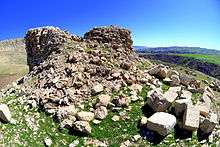Paikuli inscription
The Paikuli inscription (Central Kurdish: پەیکولی, Persian: پایکولی, in Arabic: بيكولي) is a bilingual Parthian and Middle Persian text corpus which was inscribed on the stone blocks of the walls of Paikuli tower; the latter is located in what is now southern part of Iraqi Kurdistan near modern-day Barkal village, Sulaymaniyah Governorate, Iraq (35°5′53.91″N 45°35′25.95″E / 35.0983083°N 45.5905417°ECoordinates: 35°5′53.91″N 45°35′25.95″E / 35.0983083°N 45.5905417°E). These inscribed stone blocks are now in the Sulaymaniyah Museum; the field only contains the stones that were used in the construction of the tower.[1] It was set up as a monument to victory, and tells how and why the Sasanian emperor Narseh (also written Narses) ousted his grandnephew from power.[2]

In 293 Narses marched from Armenia in open revolt against his nephew with a host of supporters and allies, whose names are recorded on the Paikuli inscription.[3] This list includes king Tiridates, possibly of Armenia. There is an opinion that this inscription shows that by this time Armenia was no longer regarded as part of Eranshahr, a view that is reinforced from the Roman side by a remark found in Ammianus Marcellinus.
Background
The Paikuli inscription of Narses shows that Asuristan (Babylonia) at least was in Persian hands, but says nothing of Nisibis and Singara.[4]
The fact of Amru's vassalage to Narses was preserved by the latter in the Paikuli inscription.[5]
| “ | Paikuli inscription may be devoid of much historical information because it belongs to the genre of epic literature composed since time immemorial in the ancient Near East.[6] | ” |
In the 19th century, when it was visited by several travelers, it consisted of the ruins of a large, square tower that had originally been covered on all sides by stone blocks, some contained inscriptions, but, at the time, lay scattered all around the monument.
Sassanians
In Tabari and sources that follow his work, and also in the Paikuli inscription of Narses, a son of Papak called Shapur is mentioned as his successor, although the text of the inscription of Paikuli in which king Shapur appears is unclear because of long lacunae. Some suggest that Narses in the inscription sought to compare his succession to the throne with that of his grandfather Ardashir, just as Ardashir had succeeded Shapur.
| “ | S. Mori contends that the Paikuli inscription is basically relating the traditional Near Eastern story of how a king achieves supremacy with the aid of the gods in the epic form. He also believes that the early Islamic texts, such as al-Tabarī are of little use for the history of the Sasanian period.[7] | ” |
References
- ↑ Amin, OSM. "Visiting the Paikuli Tower Built by the Sasanian King Narseh". www.ancient.eu. Ancient History Encyclopedia. Retrieved 19 March 2015.
- ↑ Jacob Neusner, A History of the Jews in Babylonia, Vol. 12, p. 3.
- ↑ Alan K. Bowman, Peter Garnsey, and Averil Cameron, The Cambridge Ancient History, p. 494.
- ↑ C. E. V. Nixon and Barbara Saylor Rodgers, In Praise of Later Roman Emperors: The Panegyric Latini, p. 69.
- ↑ Joel L. Kraemer, Israel Oriental Studies, p. 21.
- ↑ P.O. Skjærvø and H. Humbach, The Sassanian Inscription of Paikuli, Wiesbaden, 1983, p. 44.
- ↑ "The narrative structure of the Paikuli Inscription," Orient 30-31 (1995): 182-193.
Bibliography
- P.O. Skjærvø and H. Humbach, The Sassanian Inscription of Paikuli, Wiesbaden, 1983.
External links
- The Sassanian Inscription of Paikuli
- The Sassanian Inscription of Paikuli by Prods Skjærvø
- Herzfeld and the Paikuli Inscription at Encyclopaedia Iranica